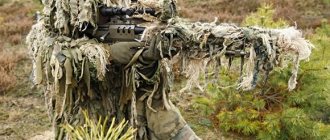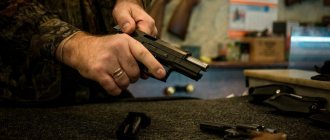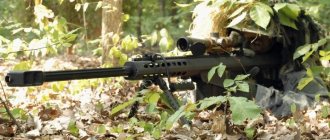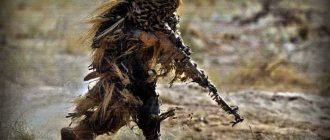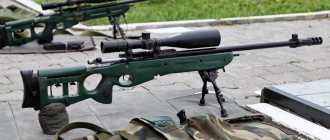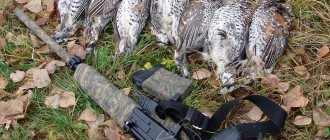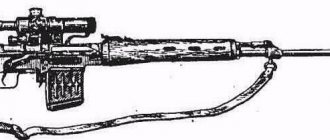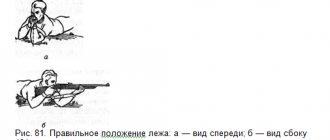How Bradley Cooper turned into Chris Kyle
For his starring role in Sniper, actor Bradley Cooper, who plays Chris Kyle, the most famous sniper in US military history, had to gain 17 kg of lean mass and transform from a sweet boy to a burly asshole.
There have been a lot of rumors about Cooper's training program. How did he actually train? And what kind of liquid was in those bottles with which reporters constantly caught him?
Here we'll answer those questions and give you the exact training plan that turned Bradley Cooper into Chris Kyle.
Bradley Cooper in 2015
What to shoot with?
The properties of the cartridge and bullet matter in sniper business no less than the advantages of the barrel or sight. Therefore, when we talk about precision small arms, we mean the “rifle-ammunition” system. There are many varieties of sniper ammunition available, varying in caliber, cartridge length, bullet design, and propellant characteristics, but the real workhorse is the .308 Winchester, also known as the 7.62 NATO. We are talking about “match” class cartridges, produced on precision equipment with minimal tolerances. The bullets used in this type of ammunition are designated by the English abbreviation BTHP (Boat-Tail Hollow Point).
There are a number of situations when visual determination of distance, even with a trained eye, can give an error. In some cases, objects may appear closer: in low places hidden behind hills, when viewed from above, along long straight landmarks such as rails, or against a contrasting, uniform background such as snow or sand. In other cases, objects may appear further away than they actually are: against the background of large objects and structures, when looking up, in a narrow space or in a visible depression.
The term boat-tail refers to the bullet's characteristic conical tail. The tail cone, by reducing the leading part of the bullet, thereby improves its aerodynamic characteristics, reduces speed loss and increases resistance to side winds. The bullet also has a cavity in the head (hollow point) - this enhances the lethal effect. 168-grain .308 Winchester sniper cartridges with BTHP bullets are produced by Remington, Hornady, Lapua, Norma, Federal, and others. .223, .300, and even half-inch .50 caliber cartridges (for large caliber rifles) are also used in sniper business.
Dmitry Mamontov Oleg Makarov
"Knocking down beauty"
“I would advise you to tie yourself with a rope - I will drag you along my path to knock all the beauty off you,” Chris Kyle said in his first phone conversation with Bradley Cooper.
“Thank God I was able to talk to him on the phone. It was a very short conversation. But I had time to tell him how serious I was about making this film,” Cooper told the USA Today show. “He needed to know that no matter what he heard about Hollywood, he just needed to trust me. That I will do everything to tell his story correctly.”
More than just another movie role
A short time after talking with Cooper, Kyle and his friend were shot and killed by a young sailor in his house in Texas. This changed everything for Cooper. Cooper said the only way to be sure the movie will bring Kyle back to life is if his family likes the movie. “He deserved it. We have stepped on the path of testing,” Cooper said.
Cooper knew he would have to change physically and become a Navy SEAL. It was obvious. But he wanted to go further. It became more than a role for him. It became a promise.
From slim to brutal strength
Bradley Cooper in 2014
In addition to rigorous combat training with the Navy SEALs, Cooper also prepared to change his appearance to become a muscular sniper, whom his enemies nicknamed “the Devil of Ramadi.”
Cooper turned to trainer Jason Walsh of Rise Movement Studio, who is known for transforming actors and actresses for film roles. But Cooper was already in good shape. That made all the difference. There had to be more to it than adding muscle here and there and getting Hollywood abs.
Kyle, before joining the army, worked on a ranch and participated in rodeos, bridling semi-wild horses. He looked rather rugged—broad shoulders, ruggedness—and you couldn't create that look with three layers of clothing and good lighting. Kyle was a strongman and a warrior, not a bodybuilder.
Cooper needed to gain 17-20 kg to accurately play his role, and it had to be mostly muscle. What's important is that Cooper didn't just have to look strong, he had to become strong. There was no other way.
For one scene, the crew was going to give Bradley fake weights for a workout scene. Cooper insisted on real scales - but he had to prepare for that.
Read also
From a position of strength
From a position of strength, the United States of America has long strived for economic world dominance, and after the end of the Second World War, for political dominance. For many years the Soviet Union remained the only real force capable of containing these aspirations.
V. How to get out of the most difficult positions
V. How to get out of the most difficult positions 1. Sq. Sertorius in Spain, urgently trying to cross the river, since the enemy was pressing from the rear, erected a shaft on the bank in the form of a concave moon, piled wood on it and lit it; Having thus cut off the enemy, he freely
Chapter 3. The third stage of activation in the Far East - on the way to strengthening positions
Chapter 3. The third stage of activation in the Far East - on the way to strengthening positions Beginning of the 90s. The 19th century was marked by the intensification of Russian policy in the Far East. At the end of 1886, a Special Meeting was convened, at which it was decided to begin in 1891
Strengthening positions
7. Strengthening positions Already in September, the army headquarters began to insistently demand that we strengthen the positions occupied and prepare and strengthen them in the rear. At that time, there was a fashion, based on the experience of positional warfare on the Western Front (in France), for fortified strips, that is
Shelling of own positions
Shelling of their own positions If the Americans managed to straddle the exits or embrasures of underground structures or capture ground trenches, then immediate shelling of the surrounding area followed from pre-selected guns[127]. Basically, this was fire from mortars,
Construction and location of artillery positions
Construction and location of artillery positions Later, during the Afghan war, dushmans would install mortars in pits, pouring water on the ground, and covering the position with burlap with a longitudinal slit - this way they avoided raising dust and hid the sheaf of flame when
Construction of defensive positions on slopes of heights opposite to the enemy
Arrangement of defensive positions on slopes of heights opposite to the enemy This tactical technique is quite widely known and within the framework of this article, it probably makes no sense to repeat it. Let us pay attention to just one factor that is usually overlooked.
I can’t see, but I’m shooting: machine gun fire from indirect firing positions
I can’t see, but I’m shooting: machine gun fire from covered firing positions. In contrast to the army and SS troops, the armament and training of the parachute regiment made it possible to fire from heavy machine guns using covered firing positions - a factor that played a role
1.3.2. General information about the role of communications, topography, and fortification in the work of a physician. Selection of positions, places for a first-aid post, search for victims, etc. Set of installations.
1.3.2. General information about the role of communications, topography, and fortification in the work of a physician. Selection of positions, places for a first-aid post, search for victims, etc. Set of installations. It goes without saying that a real study of communications, topography and fortification in the scope of a given number of studies
Decoy for sniper purposes
Bait for sniper purposes In sniper fishing, when destroying enemy personnel, there are no prohibited techniques. If an enemy soldier appears in an open place, the sniper will not kill him outright, but wound him in order to shoot those who try to help the wounded man, and
The plan was made
Bradley Cooper in the middle of the program
Walsh was going to train Cooper harder than he had ever trained. He met with trainer Ben Bruno and listened to his ideas, then formed the final twice-daily workout plan that would lead to his goals. Not only was Walsh going to train Cooper four hours a day, he was going to train with him, declaring, “I love getting to know my clients who have to deal with such intense training. The camaraderie helps keep you motivated.”
“Bradley never missed a workout. He showed up early, trained brutally, and followed the supplement prescriptions. He showed a dedication to training that is rarely seen among actors,” says Walsh. “Such intensive training is unfamiliar to Hollywood residents. These were not easy exercises. In the mornings he worked out like a strength athlete. then he would come back in the afternoon and build muscle again.”
Walsh adds that it wasn't just training that helped Cooper get into shape. He only used them as a springboard to become Chris Kyle. The intensity of the exercises brought him into the desired format of consciousness. Cooper always hung a photo of Kyle on the wall of the gym and put on a playlist of Kyle during training, listening to the exact music that Kyle loved - from Metallica and Slipknot to Toby Keith.
The only way for Cooper to gain 20kg of muscle was to push his limits. Cooper had to follow a clear plan, using a proven pattern of progress. Walsh traveled everywhere with Cooper to make sure everything went according to plan, even going to his shoot in Morocco.
Walsh knew that Cooper needed to not only survive the training, but also recover from it as quickly as possible so he could do the same thing the next day. He needed the right fuel.
Sniper training. Part 1: Necessary training, camouflage, group work
Among all modern soldiers, the sniper is in a special position. The very name of this military profession evokes respect bordering on fear. This man with a gun can do what others cannot, namely, hit a target from a long distance with pinpoint accuracy. Sometimes, when the target itself does not even suspect that it is at gunpoint.
But here, I think, a small disclaimer should be made. Sniper is different from sniper. Who is considered a sniper? For example, in the Soviet army there was a sniper in every motorized infantry squad. This was the name of the position in the staff list. One of the fighters was assigned an SVD sniper rifle, but subsequently this fighter did not undergo any special training other than a shooting course. An equally sad situation was observed in the landing force, and only in the GRU units the situation was better.
Afghanistan and then Chechnya made their own adjustments. Now in the Russian army, and after it in some others, they began to approach the training of snipers more responsibly. Allocate separate time at the shooting range and conduct tactical training. But not every one of these “men with a gun” can be called a sniper. Formally, there were many snipers, but in reality, not everyone met the standards. Therefore, in the future, in this article we will call a sniper a professional who has made sniper craft his profession.
Translated from English, “sniper” means “sharp snipe shooter.” In reality, no matter how cruel it sounds, a sniper is a hunter of people, invisible, elusive and merciless. A sniper is a representative of a special breed of people. He does not have that boorish arrogance, ready to result in a scandal for any reason, so valued in sergeants and corporals, whose task is to keep the soldiers in obedience, dripping on their brains every second. A sniper is a very calm and balanced person, not prone to loss of self-control and manifestation of negative emotions. Even if a nervous, impulsive, touchy, irritable person, prone to panic and loss of self-control, is an excellent shooter and has excellent physical characteristics, he will be eliminated at the initial stage of selection. There is no point in training a person who, due to natural character abilities, can suffer a nervous breakdown and fail a combat mission. In addition, the sniper must have an above average level of intelligence, as well as good physical training, but if physical training can be raised to the required level, then the character cannot be corrected. As they say, blood is a great thing.
So, at the initial selection they take on the following people as snipers:
- good shooters
- having good vision (preferably one hundred percent)
- responsible, disciplined, emotionally balanced
- no contraindications for health
Snipers are trained both individually and as part of a tactical assault group.
The main skill required is the ability to shoot accurately.
Without this skill, everything else becomes meaningless. First of all, the cadet is taught to shoot from a prone position from a rest position. Since in practice a sniper has to shoot from different positions, he is taught to shoot while lying down without resting, shooting from his knees, shooting while standing and sitting.
The instructors teach the technique - they teach you how to aim correctly, teach you how to hold your breath correctly, and teach you the correct descent technique. Eliminate technical errors, such as blinking at the moment of shooting, delaying aiming (aiming), excessive tension of individual muscle groups and other flaws.
Below we present one of the programs for improving marksmanship.
The content of the article
Accuracy training exercises
Exercise 1 Shot from a cold barrel
Shooting is carried out at two head targets at a distance of 100 meters from a prone position/from a rest position. The sniper may use a weapon belt, bipod, sandbags, or other equipment he may have during the operation. After the command, the sniper has unlimited time to fire a shot at the center of the left target, reload and shoot at the right target. During an operation, the sniper does not have the opportunity to fire a sighting or test shot, so a shot from a cold barrel tests both the shooter and his weapon and their ability to hit the target with the first shot. The second shot is intended to develop the sniper's skill in reloading the weapon and firing the shot automatically if the target does not fall after the first shot.
Exercise 2 Group
While in the same shooting position (prone/rest position), the sniper has unlimited time to fire a group of five shots. The target should have a small but clearly visible point of aim when performing this exercise. It is designed to test the stability of the rifle, scope, ammunition, and shooter.
A group with a radius of more than 2.5 cm should alarm a good shooter with an excellent weapon, but for a beginning shooter with an average weapon, a result of less than 5 cm is quite satisfactory. It is necessary to strive to ensure that the radius of the group is less than 2.5 cm
Common causes of scatter are loose screws in the sight and mechanisms, unbalanced barrel, malfunction of the trigger mechanism and insufficient shooting skills of the shooter.
Exercise 3 Lying without support
During this exercise, snipers must fire five shots from a prone position without support (without a bipod or sandbags) at a reduced-size silhouette target. During the exercise, we observe the ability of snipers to fire using a belt. During an operation, the sniper's firing position may not always allow the use of a rest.
Experienced snipers with properly fitted belts, gloves and shooting jackets are able to shoot a group with an accuracy of less than 7.5 cm. Less experienced shooters may be satisfied with a result of less than 15 cm. Comfort of position and breathing control play an important role in this exercise.
Exercise 4 Shooting on command
The shooters load five rounds and fire one shot at the head target for each command. This drill is performed from a prone/rest position, and the sniper must fire within a second of the command being given. At the moment the command is given, the sniper is already in position and aims at his target.
The instructor ensures that the center of the target is consistently hit on command. Again, good shooters should stay within a 5 cm circle. At the same time, bullets hitting a 10 cm circle will result in the “death” of the enemy.
Exercise 5 Volley shooting
Each shooter in the line is assigned a target (paper or 3D head target). A countdown is given from 5 to 1. On the count of 1, all snipers must simultaneously fire one shot. This exercise is repeated five times.
All targets must be hit with five shots to the center and each volley must sound like one loud shot. The instructor observes the shooting to identify shooters who shoot too early or, conversely, too late. Such shooters “don’t know their trigger.”
Volley shooting is important when conducting ambushes and in situations where several terrorists must be eliminated immediately. A premature shot can warn the criminals and they will have time to take cover or start killing hostages.
Exercise 6 Shooting at 200 meters
After moving to the 200 meter range, snipers should prepare positions for prone/rest shooting as quickly as possible. Using known sight settings or aiming distances, snipers fire five shots at the head target. Shooting can be carried out with a time limit or by command
An acceptable result would be a center of the head hit with a scattering diameter of 7.5 - 10 cm. Some shooters will be satisfied with just hits to the head, while others may get a scattering group less than 5 cm in diameter.
Exercise 7 Shooting at 300 meters
After moving to the shooting area at a range of 300 meters, snipers fire five shots, aiming for the chest area. The shooting position is prone/rest position. Snipers must be given sufficient time to make a well-aimed shot. The firing range of 300 meters is practically the maximum for a police sniper due to the fact that identifying a target by face at long ranges is very difficult.
When shooting under ideal conditions at a range of 300 meters, the standard is a group of hits in the center of the chest with a diameter of 12 - 15 cm. Wind speed of 18 km/h (5 m/s), blowing at an angle of 90 degrees to the shooting plane, deflects the bullet by 12 - 17 cm from the aiming point when shooting at a distance of 300 meters.
Exercise 8 Shooting after loading
A popular exercise is shooting after a load. The shooters quickly run 100-300 meters to the firing line, after which, again, they fire at the target at a fast pace. Push-ups, sit-ups, and rope climbs can also be used to increase your breathing and heart rate.
When the shooter is “ripe” to work in difficult conditions, they move on to special types of shooting, such as
- Shooting in a limited time at a normal pace (rapid shooting)
- High-speed shooting with transfer of fire into depth
- Rapid fire with fire moving along the front
- Rapid shooting with dash
- High-speed shooting with dashing in an extremely limited time, the so-called “fuss”.
Regardless of shooting experience, each sniper must periodically retake a marksmanship course. Even experienced snipers at times experience deficits in the application of marksmanship fundamentals as a result of practicing other skills and abilities.
Disguise
Another important skill is the ability to camouflage on terrain.
A sniper is a hunter, and therefore must be invisible. Working without disguise, the sniper himself becomes a victim instead of a hunter. Positions often have to be selected and equipped close to enemy positions. Therefore, the camouflage of the sniper’s position should be natural and not stand out from the surrounding landscape.
The position should only be occupied and equipped at night. And you need to crawl into position. When setting up a position, you cannot stand not only at full height, but even on all fours.
In the army, in peacetime, snipers sometimes devote more than half of their time to arranging and camouflaging cover, both the main one and the backup one. In addition, they are required to train covertly and unnoticed to cover distances of 200-300 meters on their bellies, squeezing into the folds of the terrain. Training in selection, equipment and camouflage of positions at night is mandatory. During the day, a visual demonstration of the errors, errors and shortcomings of such camouflage is made.
Such training takes place in various places - in a field, in a forest, at the intersection of ravines, on the outskirts of abandoned villages, landfills, construction sites, in any ruins, at different times of the day and under different weather conditions. Training sniper work in a constantly changing environment with the obligatory achievement of real results develops tactical thinking in the sniper.
Developed tactical thinking among snipers of any branch of the military - both military and operational special forces - allows them to quickly navigate in an unfamiliar environment, aggressively take the combat initiative into their own hands and not release it in the most unexpected turns of events.
The work of a sniper as part of a unit
During tactical training, snipers practice actions as part of units, and also learn to perform specific combat missions, such as:
- destruction of enemy command personnel
- disruption of the work organization of the enemy's front line
- sniper terror and demoralization of the enemy
- observation of events on the enemy’s side, study of the location of his fire weapons, observation, correction and command posts and other tactically important objects.
Snipers can operate alone, in pairs, in small sniper groups, or as part of a unit.
For example, Chechen fighters during the first and second Chechen wars used small tactical groups, which included a sniper, a machine gunner or grenade launcher, and several machine gunners. While the submachine gunners and machine gunner fired heavily, the sniper hit selected targets, and the grenade launcher hunted for equipment.
During a sniper attack, the enemy sniper is hit first, then the officer, signalman and machine gunners. After this, the enemy unit becomes uncontrollable for some time.
As part of police units, snipers face slightly different tasks than army snipers. Destruction of terrorists, hunting for terrorist snipers, operational cover for police or military, and so on, depending on the operational situation and instructions from above. In addition, snipers in police units sometimes have to justify their actions in court.
Wherever a sniper serves, he is a special forces soldier due to his unique combat profile. A smart commander gives snipers almost complete freedom of action, of course, with careful coordination of tactical aspects of solving a common task. And then, in no man's land, behind enemy lines or in the city, the sniper acts independently, at his own peril and risk. The cruel necessity of life forces the sniper to work on the principle of “one shot - one dead.”
What to Remember in a Possible Sniper Threat
- a sniper usually operates as part of a group
- at night, snipers use night vision devices that allow them to detect targets up to 500 meters
- The first stage of a sniper’s work is to detect (detect) the target, so equip 2-3 firing positions and change them more often
- in the city, a sniper occupies dominant heights, located in a building, chooses a firing position in the depths of the room, which makes it difficult to detect
- a sniper fires under cover of small arms fire
- aimless shooting from small arms may indicate the beginning of a sniper's work
- sniper groups with a cover group provoke return fire, forcing fire weapons to reveal themselves
- harassing fire can only be conducted from camouflaged firing positions
- The favorite tactics of snipers is to operate from an ambush, secretly, at night, in pre-prepared (targeted) areas of the terrain
- use active night vision devices carefully
- a sniper often uses the wounded as “live bait”, to whom they will definitely come to help. In such cases, it is necessary to use limited visibility, smoke in the area, armor protection, and military equipment
- When searching for a sniper among the local population, you should remember that a distinctive feature of a sniper is characteristic bruises on the shoulder
- in a sniper war there is no rear, flank or front, the enemy can be expected from everywhere (during the day he is a civilian, and at night he is a killer of our soldiers)
Author: Alex Neronov
Read the continuation of the article
- Sniper training. Part 2
- Sniper training. Part 3
Supplements from an Expert
Bradley Cooper leaves the hall with bottles of Mag-10
Walsh approached founder Tim Patterson with this task. Could he invent a supplement that would help Cooper build strength and hypertrophy, recover quickly, and build a Navy SEAL body in a limited amount of time?
Patterson agreed, but faced a problem. He didn't want any mistake to creep into the supplement plan. So he came up with ready-to-use bottles of Plazma and Mag-10 and sent them straight to Cooper. Patterson also created a private Internet page specifically for Walsh and Cooper, where he posted a supplement plan.
“My job is to help the athlete recover and return to the gym energized and ready to train,” says Patterson. “Bradley Cooper is motivated and works hard, and the combination of both qualities always leads to success. I knew. that his successes will be beyond all expectations. I had no doubt that everything would work out.”
Derivation
The point of application of gravity to the bullet (center of mass) does not coincide with the point of application of aerodynamic forces (center of pressure, located in front of the center of mass). As a result of the action of these forces, an overturning moment occurs in the trajectory plane. But since the bullet rotates and is a gyroscope, its axis of rotation is deflected perpendicular to the plane. That is, if the bullet rotates to the right, it deflects to the right and precession occurs - vibrations in the axis of rotation of the bullet. The axis of this precession will be deflected to the right, aerodynamic forces deflect the flight of the bullet in the same direction. This phenomenon is called derivation. It depends on the speed of the bullet and its rotation speed, mass and shape. Typically, this effect begins to affect shooting accuracy only at fairly large distances (where it is most likely to be “lost” against the background of much more significant wind drift).
Scheme of shooting at an angle to the horizon
The dashed line shows the absolute drop of the bullet at a given distance. Without making special adjustments, the bullet will hit higher than the target.
Final results
Bradley Cooper and Chris Kyle
Bradley Cooper started his program weighing 93kg and finished at 112kg with the same percentage of body fat. By the end of the program he was deadlifting 212kg for 10 reps.
The program was a success. Cooper's transformation into Chris Kyle - physically, mentally, emotionally - was amazing.
Bradley Cooper training program
SCHEDULE
Monday / Tuesday / Thursday / Friday
| Time | Additive | Dosage |
| 5:30 am | Micro-PA™ Finibar™ | 6 capsules 1 bar |
| 6:15 am | Indigo-3G® Plasma™ | 6 capsules 1 bottle (500 ml) |
| 6:30 am workout | Plasma™ | 2 bottles (1000 ml) (1) |
| After training | Mag-10® | 1 bottle (500 ml) (2) |
| 2:00 | Micro-PA™ | 6 capsules |
| 2:45 | Plasma™ | 1 bottle (500 ml) |
| 3:00 workout | Plasma™ | 1 bottle (500 ml) (1) |
| After training | Mag-10® | 1 bottle (500 ml) (2) |
| Before bedtime | Mag-10® | 1 bottle (500 ml) (3) |
| (1) | The goal is to load up on Plasma but feel comfortable doing it. In other words, drink as much as you can during the first part of your workout. By the end of the workout you need to drink both bottles. |
| (2) | Take within 1 hour after training. |
| (3) | Take 30 minutes before bedtime. |
| Kcal: 1721 | Proteins: 151 g 35% | Carbohydrates: 259 g 60% | Fat: 9 g 5% |
Wednesday
| Time | Additive | Dosage |
| 1:00 before training | Micro-PA™ Finibar™ | 6 capsules 1 bar |
| 0:15 before training | Indigo-3G® Plasma™ | 6 capsules 1 bottle (500 ml) |
| During training | Plasma™ | 1 bottle (500 ml) (1) |
| After training | Micro-PA™ Mag-10® Finibar™ | 6 capsules (2) 1 bottle (500 ml) (2) 1 bar (2) |
| Before bedtime | Mag-10® | 1 bottle (500 ml) (3) |
| (1) | The goal is to load up on Plasma but feel comfortable doing it. In other words, drink as much as you can during the first part of your workout. By the end of the workout you need to drink both bottles. |
| (2) | Take within 1 hour after training. |
| (3) | Take 30 minutes before bedtime. |
| Kcal: 1268 | Proteins: 102 g 32% | Carbohydrates: 175 g 55% | Fat: 18 g 13% |
Saturday/Sunday – no training
| Time | Supplements | Dosage |
| 0:00 preload | Micro-PA™ | 6 capsules |
| 1:00 stimulation of protein synthesis | Mag-10® Finibar™ | 1 bottle (500 ml) 1 bar |
| 5:00 preload | Micro-PA™ | 6 capsules |
| 6:00 stimulation of protein synthesis | Mag-10® Finibar™ | 1 bottle (500 ml) 1 bar |
| Before bedtime | Mag-10® | 1 bottle (500 ml) (1) |
| Note: The goal is to stimulate protein synthesis twice in six hours. | |
| (1) | Take 30 minutes before bedtime. |
| Kcal: 972 | Proteins: 92 g 38% | Carbohydrates: 110 g 45% | Fat: 18 g 17% |
Magnus effect
Since the bullet rotates in flight, during a crosswind it can be affected by the Magnus effect, which consists in the fact that when an air flow flows around a rotating body, a force directed perpendicular to the flow movement acts on the body. On the side of the bullet where the direction of rotation coincides with the direction of the flow around it, the speed of air movement increases, on the other side it decreases. The pressure difference produces a force directed in the direction where the direction of rotation and the direction of air flow coincide. The Magnus effect does not have a noticeable effect on practical shooting results, so it is usually neglected.
Tips for a sniper
1. The barrel must not come into contact with anything! 2. Press the trigger with the most sensitive part of the index finger. 3. To set the position of the stock, place a bag of sand under the butt. By pressing on it with your non-firing hand, you can make fine adjustments in height. 4. The distance between the eye and the eyepiece must be precisely maintained in order to see the entire visual field completely and without distortion. Typically this value is 7-10 cm. 5. If time permits, it is necessary to secure the position of the rifle with a belt. 6. Do not let the weapon fall down. 7. It is better to use a sandbag rather than a standard bipod as a stop.
